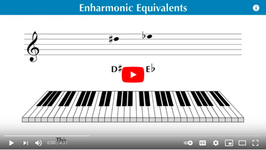Introduction To The Staff | How To Read Notes On The Staff
All musical notation is written on a collection of lines and spaces called a staff.

Each of the five lines and four spaces represents a note with a different letter name depending upon which clef is found at the beginning of the staff.


The two most commonly used clefs are the treble clef and the bass clef.


As its name would suggest the treble clef is home to notes of higher pitch frequencies than the bass clef. Therefore, when combining is clef into a grand staff the treble clef would be placed on the staff above the bass clef.

Another way to think about it is that the treble clef contains notes which are above middle C, and the bass clef contains notes which are below middle C. Here’s middle C.

As previously mentioned each space and each line of a staff is designated certain notes based upon the clef. Here’s a quick and easy way to remember the letter names of the notes on a staff with a treble clef.
The four spaces from bottom to top spell out the word face - F, A, C, E.

With this in mind you’ll quickly be able to identify any letter name on any given space of a staff with a treble clef.
Let’s put this into perspective. By simply knowing that F is the first letter in the word “face” you can easily figure out that the first space on the very bottom of the staff is the note F.

Likewise, by knowing that A is the second letter in the word “face” you’ll also see that the second space from the bottom is the note A, and so forth.

As for the lines of a staff containing a treble clef, they each can be thought of as part of an acronym for the phrase, “Every Good Boy Does Fine”.

By just memorizing this short phrase you’ll be able to quickly identify any letter name on any given line of a staff containing a treble clef.
Here’s why: If you remember that “Does” is the fourth word in “Every Good Boy Does Fine” then you will easily see that the fourth line from the very bottom is the note D.

Although slightly different than the treble clef, the same sort technique can be used in order to remember the notes on a staff containing a bass clef as well.
With a bass clef, the spaces respectively from the bottom are A, C, E, and G.

Now, remembering this isn’t as easy as simply remembering the word “face” as was the case with the spaces of a staff containing a treble clef. However, if A, C, E, G is looked at as an acronym for “All Cows Eat Grass” it becomes much easier to memorize.

For example, “Eat” is the third word in “All Cows Eat Grass”. Knowing this allows you to immediately recognize that the third space from the bottom is the note E. Eat, E.

Finally, the lines of the bass clef from bottom to top, G, B, D, F, A can be seen as an acronym for “Great Big Dogs Fight Animals”.

Being that “Good” is the first word in “Great Big Dogs Fight Animals”, G is then obviously the note found on the first line of the staff.


